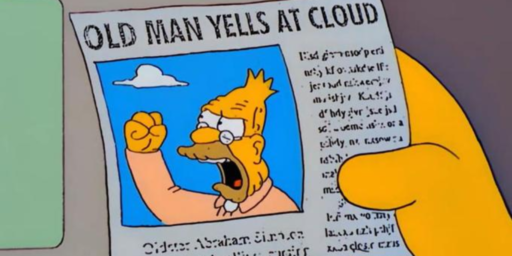Age Inversion in American Politics?
Suddenly, old voters are aligning Democrat and young ones Republican.

POLITICO (“The polls are suggesting a huge shift in the electorate. Are they right?“):
Something weird is happening beneath the overall stability of the early 2024 polling — and it’s either a sign of a massive electoral realignment, or that the polls are wrong again.
Polls show former President Donald Trump is ascendant with the youngest bloc of the electorate, even leading President Joe Biden in some surveys, as less-engaged young voters spurn Biden. Meanwhile, Biden is stronger with seniors than he was four years ago, even as his personal image is significantly diminished since he was elected last time.
That would be a generational shift: For decades, Democratic presidential candidates have overwhelmingly won young voters, and Republicans have done the same with the other end of the electorate. Poll after poll is showing that’s flipped this year.
If these changes are real, it would have profound effects on the coalitions both campaigns are building for November. No Republican has won young voters since George H.W. Bush’s landslide victory in 1988, and no Democrat has carried the senior vote since Al Gore hammered Bush’s son, George W. Bush, on Social Security in 2000.
Or something’s wrong in the polls — and the mirage of an “age inversion” is really a warning sign of a structural problem in the 2024 election polling.
That would be a signal that the polls are once again struggling to measure the presidential race accurately after underestimating Trump in the previous two presidential elections. Maybe the young-voter numbers are wrong, and the polls are understating Biden; or maybe the older-voter numbers are wrong, and Trump is even stronger than he appears; or both.
“Seems like we know how to poll white, middle-aged people really well,” said John Della Volpe, the director of polling for the Harvard Kennedy School Institute of Politics and an expert on polling young voters. “But if they’re younger, older, Black, Hispanic — there seems to be no consensus about what’s the best practice these days.”
There’s a longstanding concern that, as most of us move away from landline phones to being cellular-only, polling will become less accurate. I, for one, have my phone set to automatically reject callers who aren’t in my phone’s contact list.
The thing is, despite a spate of columns arguing otherwise, polls have continued to be pretty damn accurate at predicting the outcomes of American elections. Thus, I’m inclined to believe that the “inversion” being shown in the polls is real and part of the larger sorting going on in our politics.
Just last week, a new NPR/PBS Newshour/Marist College national poll showed Trump 2 points ahead of Biden among Millennial and Gen-Z voters, while Biden led overall among voters 45 years and older, including those in the Silent and Greatest generations.
That’s a weird framing. Silents (the generation Biden himself is in) were born between 1928 and 1945 and thus between 79 and 96 years old! The “Greatest” Generation were born between 1901 and 1927, and are thus between 97 and 123; there aren’t all that many of them left.
A Fox News poll last month showed Trump leading Biden among voters under 30 by a whopping 18 points in a head-to-head matchup — and by 21 points with independent and third-party candidates included.
I tend to dismiss Fox’s polls. And both of the cited surveys are of registered voters, thus without a likely voter filter. Still, to the extent others are showing the same thing, I’m inclined to think it’s a real phenomenon. Alas . . .
Not every poll shows a perfect age inversion.
Biden is at just 50 percent among voters under 30 in the Wall Street Journal’s national and swing-state polling. While that’s still about 10 points ahead of Trump, it’s a significant decline compared to the 2020 election — and roughly equal to his vote share among seniors, 48 percent.
A Quinnipiac University poll released last week had Biden 20 points ahead of Trump among voters under age 35, close to the president’s margin in 2020 according to exit polls and other estimates of voting subgroups. But that survey also had Biden ahead by 8 points among voters 65 and older, which would be a significant reversal from recent elections, when Republicans won older voters.
So, the polls are not particularly consistent on this. That may simply be a function of their using different age cohorts. Or the fact that the margin of error is very much higher for subsamples than for the whole polling sample.
On paper, it might seem like a good trade-off for Biden: Young people turn out to vote at significantly lower rates than seniors. According to census data, 48 percent of voters under age 25 participated in the 2020 election, compared to 73 percent of those between the ages of 65 and 74, and 70 percent of those 75 and older.
But winning over older voters doesn’t appear to be boosting Biden in the polls, which show him essentially neck-and-neck with Trump, with the Republican narrowly ahead in most swing states.
That’s just a non-sequitur. Expressing a preference and taking action are two different things. If the gains among old voters are roughly the same as the losses among the young, the way to bet is that this is a net gain in turnout.
Regardless, Nate Cohn is running with the inversion theme and has a cute explanation for it (“How ‘All in the Family’ Explains Biden’s Strength Among Seniors“):
Mr. Biden’s strength among seniors might be surprising, but the likeliest explanation is deceptively simple: At every stage earlier in their lives, many of today’s seniors voted Democratic. They just got older.
To understand why, consider Archie Bunker, the working-class “lovable bigot” from the 1970s hit sitcom “All in the Family,” and his TV family.
[…]
It’s not unreasonable if Archie is your image of an older voter. As recently as 15 years ago, every single voter over age 65 was born before the end of World War II and came of age before the cultural revolution of the 1960s that shaped the views of many baby boomers voters for a lifetime.
Archie’s generation was the only one that reacted to the 2008 nomination of Barack Obama by shifting right: A higher share of them voted for John McCain in 2008 than for George W. Bush in 2004.
But in 2024, Archie shouldn’t be your image of a senior. Archie would be 100 years old today; his generation, called the Greatest Generation, has almost entirely died. The generation that came after Archie’s — the conservative Silent Generation, who grew up during the popular Eisenhower presidency in the “Leave It to Beaver” 1950s — has mostly died, too. Just 20 percent of the Silent Generation is alive today.
Instead, you may be better off thinking of Michael and Gloria. They are boomers, and they would be in their 70s today.
As a result, today’s seniors bear little resemblance to those from 10 or 15 years ago. Today, Madonna is a senior. So are Ellen DeGeneres and Katie Couric. By Election Day, Magic Johnson will be 65. Even though they may not feel like older voters to you, these boomers are the new seniors.
All together, boomers will make up more than 70 percent of seniors in 2024, up from zero percent when Mr. Obama — himself a baby boomer — won the presidency in 2008.
It’s an obvious point but one that analysis often misses: age, income, and other categories aren’t static. The Silents and Greatest are quickly dying off and being replaced by Boomers and Xers in the older ranks. It’s natural that they’re going to have different ideological views than their parents and grandparents.
Likewise, while it’s hard for me to understand why Trump would be appealing to someone under 35, that young cohort has endured wave after wave of systemic shock, from the Great Recession to COVID. While Biden is trying to help with various policy proposals (like student loan forgiveness), he represents The Establishment in a way that Trump simply doesn’t.






No one under the age of 30 has ever answered a phone call absent caller ID. Hell, I don’t do it, and I’m old. I understand the pollsters think they’re compensating for that with magical algorithms, but I don’t know how you extrapolate from a set of zero respondents.
Putting aside for the moment the question of whether polls accurately predict the outcome of elections, polls definitely have a mediocre record of predicting specific demographic shifts months in advance of elections. We’ve seen these sorts of sensationalized headlines fail to pan out before, due to nonrepresentative sub-samples and reading too much into voter ambivalence before an election, where a lot of voters fail to express a commitment then end up voting pretty predictably for their group.
“Pretty darn” is doing a heavy, heavy lift here.
I’m old enough to remember pundits were cherry-picking polls to insist a big huge giant red wave was coming in 2022, and that there was some big realignment coming with Latino voters shifting towards Republicans.
When the dust settled, Republicans barely won the House, Democrats won the Senate, and Democrats won about the same share of Latino voters in 2022 as they usually do.
For some reason, pundits just cannot give up on cherry-picking polls to make overheated declarations. But Trump will not be winning youth voters in November of 2024, and it won’t be close.
I don’t really trust these polls. And especially when it comes to young people, their views are fickle and change as they get older.
As for old people, yes, we have a new generation that is not the same—the late Boomers and early GenX. My guess is that this cohort may be more aware of Social Security’s looming insolvency in the next decade and trust Democrats more to address the problem than Republicans.
I do think we are in the midst of a political realignment—it’s pretty undeniable. However, it’s not clear how it will shake out in the end. A big unknown is what happens to MAGA and the populist right when Trump is finally gone. If the GoP continues down the path to adopting what used to be the leftist economic positions and policies, then I could see young people gravitating toward that, as they have usually gravitated toward lefty economics.
That’s a double-edged sword. Only a small number of people benefit from forgiveness, and it’s still the case that less than half of people even go to college. So, the help is very limited and narrow, and it creates resentment amongst the much larger group of people who aren’t getting forgiveness, have paid their loans, or haven’t gone to college.
@DK:
The print folks have to generate 700-800 words on a fixed schedule, the TV people have to pretend to know things when MSNBC or CNN calls. The system does not incentivize correct analysis, it just pays for ‘content’ in the form of word count or minutes on-air.
Didn’t the 2020 polling overestimate Trump?
However accurate the top line numbers for polls are, they are terrible at capturing demographics unless they heavily oversample the groups in question. A recent survey by Split Ticket of exclusively young voters found Biden getting 35% to Trump’s 25% and Kennedy at 23%. It’s highly unlikely that Kennedy will actually receive that level of support. Among young voters who are very certain that they will vote in the fall, Biden leads 41% to 28%. Trump’s “very unfavorable” rating among those young voters was 61% to Biden’s 44%.
This suggests that young voters are not turning to Trump. Biden will need to work to get their support, but they are far more likely to simply not vote than shift to Trump.
@Michael Reynolds: Ah, yes. When I doubt, follow the money. You’re right, of course.
Fox’s polls have a surprisingly good track record. That said, I would still ignore demographic subgroups unless the poll oversamples them.
@Stormy Dragon:
No, it dramatically underestimated him. There’s a case for saying it did it even worse than 2016, even though unlike in 2016 it correctly predicted the winner. However, the error margins were bigger.
My opinion is that a lot of the polling problem in 2020 was pandemic-related: the massive shift to mail voting, and the fact that the Democratic campaigns took the pandemic restrictions more seriously than Republicans and so did a lot less of the traditional canvassing and GOTV, leading to an imbalance in turnout that the polls were unable to detect.
In any case, since 2022 a lot of polls have been underestimating Dems. This narrative has been disputed by commentators who point out that the generic ballot polls were fairly accurate (RCP had Republicans leading by 2.5, they ended up winning the House popular vote by 2.8). However, virtually all the high-profile Senate and gubernatorial races in the key presidential battleground states underestimated Dems, in some cases well outside the margin of error (for instance, Gretchen Whitmer did nearly 10 points better than her RCP avg).
@Kari Q: I’ll have to look back into their ratings. They’ve definitely had a higher Trump margin than most other national polls in this contest.
Fully agree that subsample numbers are suspect. Presumably, though, if we see a steady trend across polls showing the same thing, it bears watching.
@Michael Reynolds:
Hell, I’m as old as you (shit!) and I wouldn’t even answer a poll if I picked up for some reason. About ten years ago I was waiting for a call and answered a number I didn’t recognize. It turned out to be a pollster. I thought for a second: is this some BS push poll? Is it a scam? Is it neither but still some partisan poll? And finally: do I want to waste any part of my life on this? My answer was obvious, “Put me on your do-not-call list.” Click.
@Kari Q:
Not the only one.
The last Economist poll released on 4/5 had Biden +15 with voters aged 18-29: Biden 49%, Trump 34%, Kennedy and Others 4%. The previous YouGov poll had Biden +18 with the same cohort.
These polls don’t fit the preferred clickbait narrative that generates revenue, though. “Polls Are All Over the Place and We Don’t Know What Will Happen” isn’t a sexy headline. Especially when, due to discomfort with uncertainty, election analysis has become over-reliant on polling at expense of other metrics.
It’s better for pundits like the Nates to cherry-pick polls and write blazing headlines about red waves and unprecedented age and race realignments. As MR reminds us, sensationalism sells. Always has. Nuance, not so much.
@MarkedMan: I like to answer pollsters if I have the time, but I’ve definitely had experiences with realizing I was talking to a push pollster.
A few years ago I got a call on my iPhone from someone identifying as a pollster, but it was aimed at Marylanders. I explained to the person that I haven’t lived in Maryland in over a decade even though I still use a Maryland number. He explained he only could use info from actual Maryland residents, so we politely parted ways.
I’m 47 and don’t have a landline.
Biden – Silent Generation
Also, it was this silent generation that was the generation of the 1960s. It was Silent Nancy Pelosi, age 20, who went to JFKs inauguration not Boomer Trump, age 14 in 1960. The oldest Boomers were just 23 in 1969. The mid-Boomers who are more the stereotype were just 16. On the other hand, late Boomers such as myself had our political eyes opened by the failed Carter administration and the morning in America Reagan presidency.
The real risk is these nostalgic for the mythological ’60s voters do have a name recognition candidate in RFKjr.
As for the younger voters, it appears the spirit of Alex P. Keaton is making a resurgence in Gen Z.
@DK:
I agree with all of this.
I mentioned the poll I did only because it’s the only poll I know of that focuses on young voters specifically, meaning it’s likely to give a clearer picture of how they are feeling than a standard poll of the whole population.
@Michael Reynolds: On top of that I wonder if pollsters understand the concept of “shitposting”…
I don’t think there is any doubt Biden will handily win the youth vote, and pointing out Biden’s national margins, especially this far out, doesn’t mean much.
The important question concerns relative margins and turnout—specifically, relative margins and turnout in the swing states. A difference of a few percentage points among key demographics—not just the youth vote but certainly including them—can be decisive.
For example, Biden will certainly win the Black and Hispanic vote nationally. But if the margins in the swing states are just a couple of percentage points closer than they were in 2020, that could be enough of a difference for Trump to win.
Another example—in 2020, Biden lost ground with rural voters but made up enough ground with suburban voters in the swing states to win. These were relatively small margins of a few percent. So, related to the recent thread on rural voters, if the strategy is to write off rural voters by declaring them all to be undeserving whiny leeches, including the ~1/3 of them who vote Democrat, then you’ve got to have a plan to pick up votes elsewhere to win because all the swing states have non-trivial numbers of rural voters.
It seems difficult for some people to understand, but there are tradeoffs that can’t be avoided between the desire for ideological purity vs actually winning in a diverse polity given the realities of the electorate and how our system functions.
Amusing to see the Lefties flip to Skewed Polls motivated reasoning (while of course indeed journos/editors/ publishers at this stage under the market pressure are motivated to run click-baitey headlines and framings).
In terms of a potential Why of a (segment of) youth support to Trump the Wiki profile on educational attainement in the USA provides data to inform reflexions deeper than the overly dominant tendancy amongst the ‘Progressive’ fraction of the Left to confound Uni-Educated-Youth who are highly visible on-line and highly communicative with broad youth, taking youth as under 3o as from that page.
The data highlight that those who do not have 4 yr degrees are majority of population (looking to be 63% – but let us simplify to 60 odd percent on national basis. The 4 yr degree as per my recollection being quite the important (although not perfectly predictive) indicator of alignment in political habit terms.
The same page also shows very important regional variation of levels of this attainment – as this map helpfully shows although it is 25 over so unfortunately not precisely same data but it is reasonable to expect that the regional variation if not the actual percentages will be generally aligned as the other data points also suggest the same regional structure (2021)
This generally aligns with Swingy geographies as marginal risk zones where the Democrats – US Left overweight consciousness to Uni educated elite agenda and fairly clear disdain for non-adherents (unless of course pardonned by ethno-racial identarian favoured groups appartenance). (and fairly blindered understanding of youth = uni educated as per the discourse around college debt write off as youth panacea, although clearly favouring an already more favourably positioned demographic fraction of the age-cohort, but Own Tribe fraction…)
So if one decomposes from the National to the sub-national and specific economic class problem – at least to this outside observer it is not difficult to understand a potential appeal of Trump as a Populist reaction to a Uni-educated relative-elite dominated discourse and agenda on Democrats side. This is not, to mitigage the usual partisan knee jerking here, to say this is a correct reaction or smart or useful, but analytically it is entirely understandable as for a portion of the demographic age-cohort.
Circling back, I don’t think Lounsbury and JKB are the same person. I think Lounsbury is an AI bot. JKB is just a parrot.
@Tony W:
Lounsbury has been here for far longer than AI has been around, I’d guess he’s been commenting here for at least a decade. He’s always been a contrarian. IIRC, he’s a Brit who has significant experience doing business in the Middle East, though I do not recall what area of business.
@Andy:
Since before 1956? Can’t beat that!
@Andy: I have been reading and commenting here since the days when I had my own blog in the era of a certain American occuption in Iraq (said blog shut later as one day a certain Commonwealth based journo figured who I am – which when one is working for a PE fund and supposed to be discrete is not welcome – although luckily kept me off-the-record, for infos over beers).
My national affiliation is rootless cosmpolitan, a family of imperial confettis, the imperial métissés of a certain Moyenne orientale nature.
My job is in fact nowadays investing euros in Renewable Energy in European union neighbourhood (an official definition), hundreds of millions of euros in fact.
But contrarian I suppose I would not perhaps disagree with, congenitally critical I might call myself. For all that a significant fraction of the current population of commentators rather prefers partisan echo chambers and cheerleading My Team.
Polling has its problems, and should be taken with a grain of salt these days, but the young, white men have had a problem for a while drifting into Incel/MRA/Alt-Right territory, particularly as young women have been less willing to put up with being treated poorly.
I don’t know if it is just whether the conservatives are getting more conservative, or whether it’s a larger rightward shift, but there’s something a bit scary out there. The 15 year old boys who thought Andrew Tate was cool are now old enough to vote.
@JKB:
Alex P. liked women as people. He was kind. He wasn’t racist. He’s nothing like modern conservatives.
@Lounsbury:
Same thing was said in 2022 when “the Lefties” pointed out that Red Wave 2022!!11!! was based on cherry-picked polls, and that the full picture of all polls and metrics showed a much closer, more muddled race.
Amusing to see performative centrists doubling down on the same ole error: confusing reflexive bothsidesism with critical analysis. Not unlike everyone’s smug uncle who has no original, creative and intelligent thought of his own to contribute during family discussions, so he can only default to disagreeing with everyone.
He proudly believes his compulsive need to set himself apart makes him smart. When habitual, this behavior is usually just a trait-factor of antisocial, histrionic, or narcissistic personality disorder. (And in group therapy, it’s astonishing to observe.)
Perhaps older voters were much more disturbed by 1/6 than the young. After all they have been through many orderly and civil elections and transfers of power. Voters under 30 who have been through very few may not understand the great departure from normal the events around the 2020 election were. They also probably have a better understanding of history and civics as our schools continue to discard these classes in favor of STEM. For instance social studies has been completely absent from the ACT for years. I also believe the middle and younger boomers may never have fallen into the Fox News black hole that their elders did. These things probably only would matter at the edges, but might explain some of the polling,
Young people voting for Donald Trump is somewhat analogous to Russian citizens voting for Vladimir Putin, except that they have an obvious choice to NOT vote for a proto-brownshirt.
Seriously though, I do think that polling these days present problems that didn’t exist a generation ago. In this smartphone lack-of-landline era I’m sure the polling organizations are reworking their procedures and algorithms. That said, I see polling results, especially now 6 months out, as a snapshot in time. and not predictive or determinative, however there is value.
@Andy: There’s no way he’s a Brit!
@DK: you do love your straw men and team cheerleading, is evident, rhe recollection being in the specific for me personally (as abortion decision was clear hook, but nothing should stand in way of partisan tales)
Sterile posturing aside, the data with respect to internal geographical demographics structuring in age cohorts and educational achievement is clear, as is the recent statistics as to trending voting patterns.
Sub national reguonal political demographics and not national are the interest, whatever party political partisans team cheerleading.
@MarkedMan:
That’s what I remember, but memories are faulty, so I say that with low confidence. Anyway, it’s not very relevant to me one way or the other, but the archives are available if anyone wants to search. I won’t defend the claim, and he’s here and can speak for himself.
@Lounsbury: Is there an English translation available? Hehe.
@Andy:
If the GoP continues down the path to adopting what used to be the leftist economic positions and policies, then I could see young people gravitating toward that, as they have usually gravitated toward lefty economics.
Oh sure, any day now the GOP is going to be the pro-labor party instead of being committed to destroying the NLRB.
I do think that labor provides a key to maybe why these polls might be halfway correct. A certain type of populism which has no connection to the past or the New Deal or leftist history will conceive of a leftist heritage which is literally being a nativist who dislikes coastal elites. The fact that younger people who are academics and media types are becoming pro-labor and are unionizing is just more fuel to hating any kind organized political action and finding that hatred to be the mark of leftism. There just a lot of disconnected young people who grew up in an America where everything is the market and selfishness.
@Modulo Myself:
Well, you can laugh all you want, but Democrats are far to the right on economics, and Republicans are far to the left of where they were even two decades ago, much less three or four.
Now, who knows where things will end up. Nothing is for certain, but if trends continue, we certainly could see the GoP be the labor party in the future. Party brands can change, they are not set in stone.
@Gustopher: 😀 😀 😀
I don’t always love me some M Reynolds, but he’s 2 for 2 in this thread. And, brevity being the soul of wit, bravo M Reynolds, bravo.
@Andy:
I’m not laughing. People like you actually believe there are trends pointing towards the GOP moving left on economics when in fact they are simply moving in a more authoritarian/fascist direction, one where the great populist candidate is still promising billionaires he will keep their taxes low. Why not? The enemy isn’t owners or capital. Trump isn’t talking about PE and people like James Biden tearing into rural hospital systems. That would actually be an appeal to the real left. You guys just don’t know this. All you really get immigration and the idea that a rich guy who made his money in shifty development is less of a snob than a Harvard adjunct who grew up with a union dad and writes about labor history but is funny and not an oaf.
I do think that the Democrats really do have a problem here with younger people who think that money and being a rich guy who says what he thinks about rich people he resents is more leftist than the actual left. The GOP has dropped its worship of global finance and that has shifted the needle.
I’m trying to figure out how to square this assertion with the other one that’s coming up often, which is that younger women are much more liberal than they used to be, while younger men are staying the same. Hence the articles about how women need to suck it up and date/marry someone with different politics than themselves.
@Andy:
So, Republicans today are to the left of where they were when Nixon instituted price controls?
You really need to learn some history.
@Andy:
One of us does not know what right and left are in terms of economics.
I see one party that wants to raise the minimum wage and have a more progressive taxation system. And one party that’s the exact opposite. And most people would put the former as left and the latter as right.
You’re not stupid, so what do you mean? (It sounds stupid, but I expect you’re using a different set of metrics)
@Andy:
I don’t think it breaks down this neatly. Republicans are embracing nationalism and populism, and protectionist tariffs are part of that. On the other hand, they are still talking about cutting Social Security and Medicare, cutting food stamps, and lowering taxes. Most still talk about how bad government health insurance is, even though they’ve stopped trying to repeal Obamacare.
Democrats are not embracing protectionism, but they still support and even want to expand the programs republicans want to cut or eliminate.
Really, though, today’s Republicans don’t seem to have any fixed beliefs about economics or anything else. It’s just “Whatever Trump says, updated every time he says something different from the last time he spoke.”
@Kari Q:
Fascism doesn’t have any particular economic orientation, or policy goals at all. The entire point is that economic/ trade/ crime/ public health/etc. policy is whatever The Boss says, at the moment he says it, subject to reversal five minutes later.
As the Democratic Party has become the representative of America’s overwhelmingly white managerial class, it makes perfect sense that younger voters and minority voters would move away from the Democrats and look for an alternative.
Which doesn’t mean that’s what these polls are showing or that those voters are moving to Trump and/or the GOP. But it’s funny to read comments like this which simultaneously blast the Right for only caring about Trump while being completely ignorant of how profoundly the Democratic Party has changed since Bill Clinton because “not being Republican” is all the commentors really care about.
@TheRyGuy:
Changes in the Democratic party since Clinton? You mean Democrats no longer support things like this from Clinton’s 1995 State of the Union address?
@TheRyGuy:
Younger voters and POC go to college and are well visible in the various professions. LGBTQ and women also.
The engineering school I went to was all male, there are lots of lady engineers now.
Like rural, very Republican small businessmen?
@TheRyGuy:
Yes, I think we all can see why young women would gravitate toward very conservative Republican candidates who want to take away a woman’s ability to control her own reproductive healthcare decisions – from contraception, to misscarriages, to abortion, to invitro treatments.
@JKB:
Cool now do Eisenhower in the 50’s to see how bat s**t crazy Republicans are now under Trump.
@JKB:
Literally, yes; but the the mythical entity called “The Sixties” (the Free Speech Movement, the Summer of Love, the Chicago Convention, Woodstock, the Vietnam War, the psychedelic culture, and, in the rest of the world, the French May, the Chinese Cultural Revolution, the Swinging London, the Portuguese Academic Crisis, the Prague Spring, etc, etc.), with all the social and political connotations, is probably more the Boomer generation